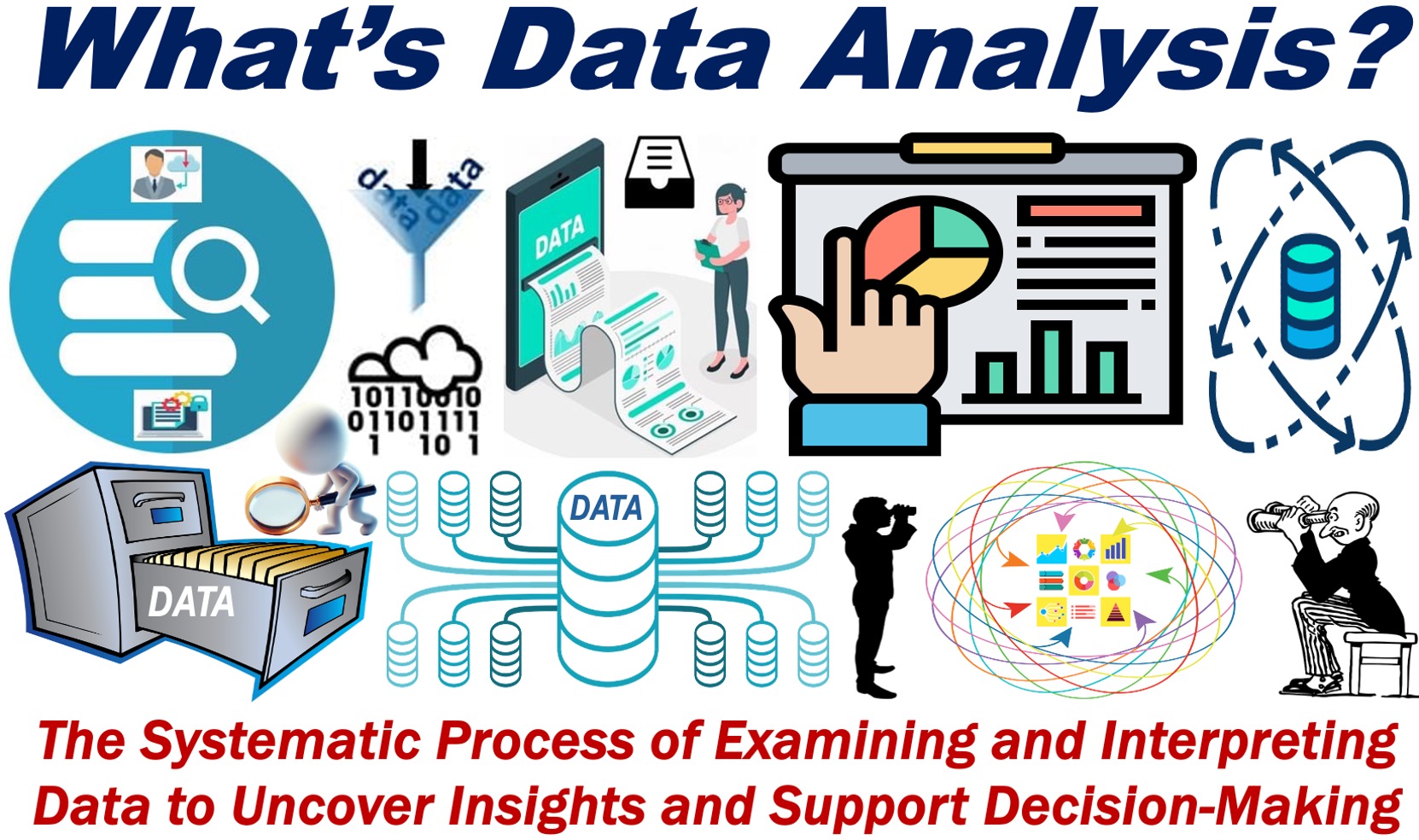Data Analysis is the process of examining, cleaning, transforming, and modeling data to uncover useful information, make informed decisions, and support conclusions. If you work with data, whether in business, research, or everyday life, you are likely engaged in data analysis without even realizing it.
Coursera.com has the following definition of data analysis:
“Data analysis is the practice of working with data to glean useful information, which can then be used to make informed decisions. When we can extract meaning from data, it empowers us to make better decisions. And we’re living in a time when we have more data than ever at our fingertips.”
Meanings of “Data” & “Analysis”
Before we continue, let’s take a closer look at the meanings of the words “data” and “analysis” in isolation:
-
Data
Data is information such as facts, figures, measurements, amounts, trends, and dimensions that we collect for reference, analysis, and to help us plan for the future.
-
Analysis
Analysis is the process of examining and interpreting data or information to draw conclusions and make informed decisions.

Data Analysis – Key Steps
Fundamentally, data analysis involves several key steps.
-
Collection
First, you collect data, which could come from various sources such as surveys, sales records, or online interactions.
-
Cleaning
Once you have the data, the next step is to clean it. This means removing any errors, duplicates, or irrelevant information that might distort your analysis.
-
Exploring
After cleaning the data, the next step is to explore it. During this phase, you might use statistical tools or software to look for patterns, trends, or relationships within the data.
For instance, if you run a business, you might analyze customer purchase history to identify which products are the most popular or which times of year see the highest sales.
-
Transforming
Once you have explored the data, the next step is to transform it. This involves organizing the data in a way that makes it easier to analyze.
For example, you might group data by time, location, or customer type. By transforming the data, you can start to draw meaningful insights that can help guide your decisions.
-
Modeling
The final step in data analysis is modeling, where you apply mathematical or statistical models to the data to predict outcomes or test hypotheses.
For example, if you are a marketer, you might use data modeling to predict how a change in advertising strategy could impact sales. This step allows you to forecast future trends and make data-driven decisions with greater confidence.
Data Analysis Helps You Gain Insights
Data analysis is crucial in today’s data-driven world. By analyzing data, you can gain insights that help you develop a better understanding of your business, customers, or any area you are interested in.
Whether you are looking to improve your company’s performance, optimize operations, or simply make better decisions, data analysis provides the tools you need to achieve your goals.
Data Analysis – Brief History
The concept of data analysis has deep historical roots, with early forms dating back to the 17th century when figures like John Graunt (1620-1674), an English haberdasher who is known today as the ‘father of demography,’ analyzed population statistics.
However, the modern concept began to take shape in the 20th century, particularly with the development of statistical methods and computing technology.
John Tukey (1915-2000), an influential American mathematician and statistician, is often credited with popularizing the term “data analysis” in the 1960s. His 1962 paper, “The Future of Data Analysis,” helped establish it as a distinct field within statistics.
The term started to gain widespread attention in the 1960s and 1970s, especially as computers enabled more complex analyses.
By the 1980s and 1990s, data analysis became a critical function in business and research, and with the explosion of digital data in the 2000s, it became an essential practice across various industries.
Other Compound Nouns
In business English, there are many compound nouns that include the word ‘analysis.’ A compound noun is a term made up of two or more words. ‘Data analysis’ is one such example. Let’s take a look at ten other compound nouns that end with ‘analysis’:
-
Trend Analysis
Examining data over time to identify patterns or trends that can guide future decisions.
Assessing potential risks in a project or decision to determine their impact and likelihood.
Evaluating market conditions to understand demand, competition, and customer behavior.
Analyzing financial data to assess the health and performance of a business.
-
Cost Analysis
Determining the costs associated with a project or operation to evaluate profitability.
Identifying strengths, weaknesses, opportunities, and threats related to a business or project. SWOT stands for Strengths, Weaknesses, Opportunities, and Threats.
-
Performance Analysis
Measuring and evaluating the effectiveness or efficiency of a process, team, or individual.
A statistical method used to understand the relationship between variables, often to predict future outcomes.
-
Impact Analysis
Assessing the effects or consequences of a particular action or decision.
A study that helps companies identify threats and opportunities. Specifically, threats and opportunities related to uncontrollable external factors. PEST stands for Political, Economic, Social, and Technological.
-
Sentiment Analysis
Using data to determine the emotional tone behind words, often in social media or customer feedback.
Final Thoughts
Data analysis is the process of examining and transforming data to uncover valuable insights.
It involves several key steps:
- Collecting data from various sources.
- Cleaning it to remove errors.
- Exploring it to identify patterns and trends.
- Transforming it for easier analysis.
- Modeling it to predict outcomes.
These steps enable you to make informed decisions and achieve better results.
Whether you’re aiming to understand your business, optimize operations, or make data-driven predictions, mastering data analysis gives you the tools to leverage the information at your disposal effectively.
